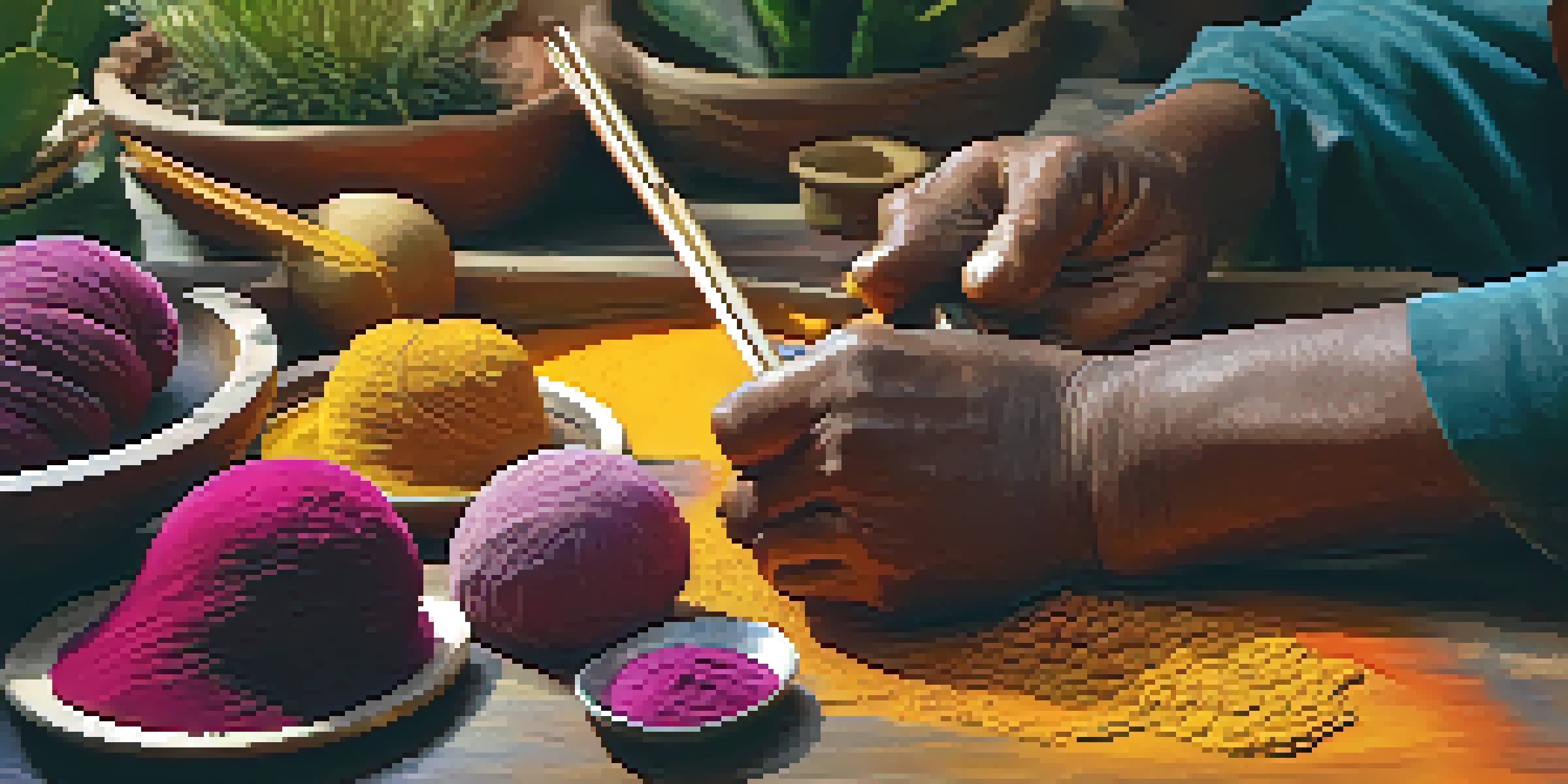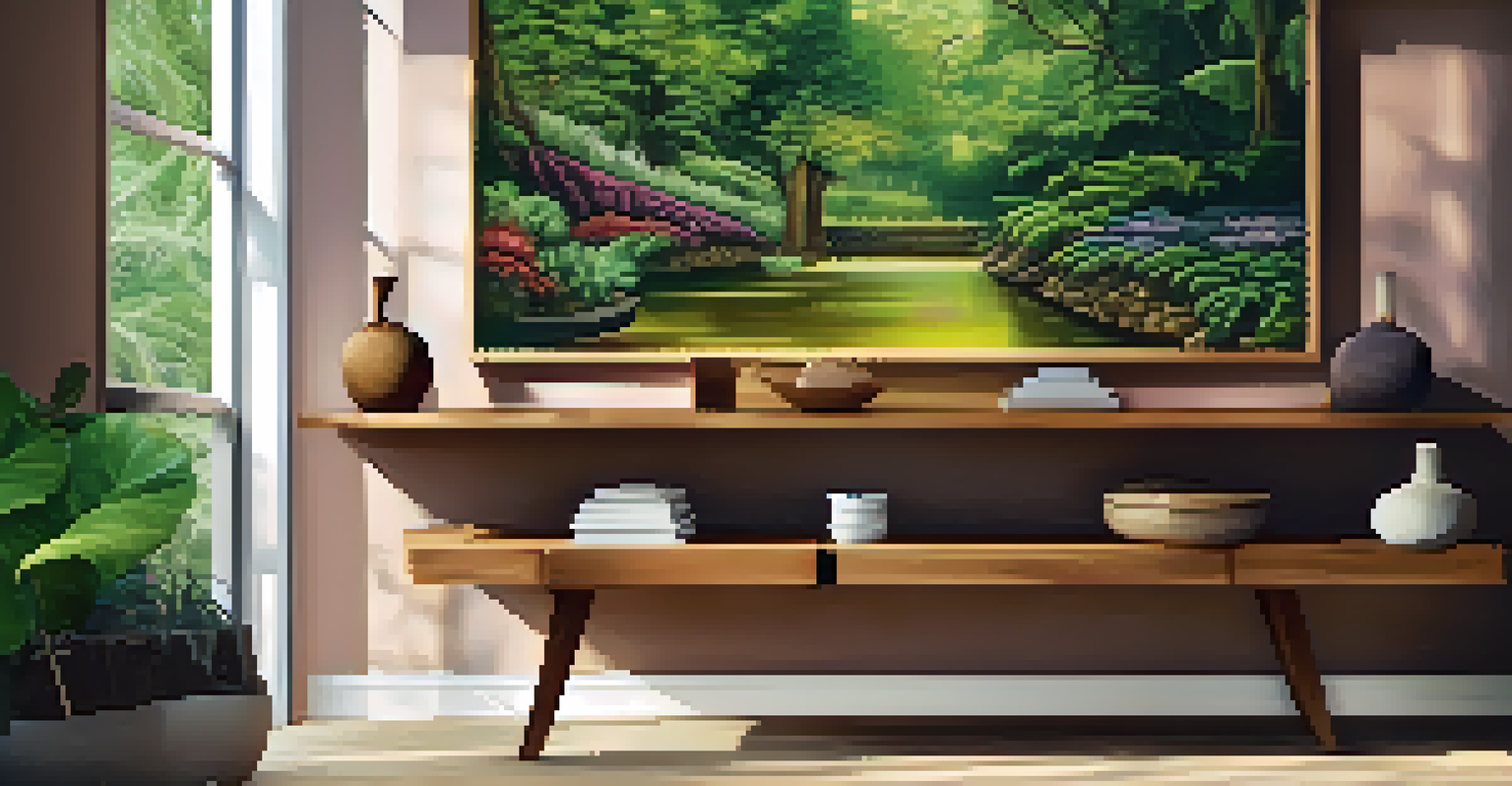Natural Dyes: Sustainable Coloring Methods for Carvings

Introduction to Natural Dyes and Their Benefits
Natural dyes are colorants derived from plants, minerals, and insects, offering a sustainable alternative to synthetic options. They have been used for centuries in various cultures, showcasing their timeless appeal and effectiveness. The shift towards using natural dyes in artistic carving not only enhances beauty but also promotes environmental awareness.
Nature is painting for us, day after day, pictures of infinite beauty.
One of the most significant benefits of natural dyes is their biodegradability. Unlike synthetic dyes, which can take years to decompose, natural dyes break down more easily, reducing environmental impact. This characteristic makes them ideal for artisans who prioritize sustainability in their creative processes.
Additionally, natural dyes often produce unique, rich colors that cannot be replicated with synthetic alternatives. Each dye can yield various shades depending on the materials and methods used, allowing artists to create truly one-of-a-kind pieces. This individuality adds value to carvings, making them even more special.
Common Sources of Natural Dyes
Natural dyes can be sourced from a variety of materials found in nature. For instance, turmeric provides a vibrant yellow hue, while beetroot can offer deep reds. Other popular sources include indigo for blues and walnut hulls for browns, showcasing the wide range of colors available through natural means.

Many artisans also utilize food scraps as a source of dye. For example, onion skins can yield beautiful golds and browns, turning kitchen waste into an artistic resource. This practice not only reduces waste but also encourages a more sustainable approach to crafting.
Natural Dyes Promote Sustainability
Natural dyes are eco-friendly alternatives to synthetic options, reducing environmental impact and supporting sustainable practices.
In addition to plants, some natural dyes come from insects, like cochineal, which produces vivid reds. Though these sources might seem unconventional, they highlight the diversity of options available for those wanting to embrace natural dyeing methods in their work.
Preparing Natural Dyes for Carving Projects
To use natural dyes, artisans need to prepare them properly to achieve the best results. This usually involves extracting the color from the source material through boiling or soaking. For instance, to create a dye from onion skins, one would simmer them in water, allowing the color to leach out before straining the liquid.
The earth laughs in flowers.
Once the dye is prepared, it’s essential to consider the type of wood being used for carving, as different woods can absorb colors differently. Some woods, like maple, may take on dye more readily than others, such as cherry. Conducting small tests on scrap pieces can help artisans gauge the final color.
Another important step is mordanting, which means treating the dye material or the fabric with a substance to help fix the dye. Common mordants include alum or vinegar, which can enhance color vibrancy and longevity. This additional preparation ensures that the dye adheres well to the carved surface.
Techniques for Applying Natural Dyes
There are several techniques for applying natural dyes to carvings, each yielding different effects. One popular method is using a brush to paint the dye onto the carved surface, allowing for precision and detail. This technique works well for intricate designs, enabling artists to highlight features and create depth.
Another approach is to submerge the carved piece directly into the dye bath. This method allows for an even, consistent color application, making it ideal for larger pieces or when a uniform look is desired. However, artisans should be cautious with the soaking time, as prolonged exposure can lead to darker colors than intended.
Unique Colors from Diverse Sources
Artisans can create one-of-a-kind pieces using natural dyes derived from various plants, minerals, and even food scraps.
Finally, spray or sponge techniques can create unique textures and patterns. These methods allow for more creative freedom, enabling artists to blend colors or achieve gradient effects. The versatility of these techniques allows for endless possibilities in artistic expression.
Colorfastness and Care of Naturally Dyed Carvings
One common concern with natural dyes is colorfastness, or how well the color holds up over time. While natural dyes can fade more quickly than synthetic counterparts, proper care and finishing can enhance their longevity. Applying a sealant, such as natural oil or wax, can help protect the dyed surface from moisture and sunlight.
It's also beneficial to store naturally dyed carvings away from direct sunlight to minimize fading. Keeping them in a cool, dry place can help maintain their vibrant colors. Regular maintenance, such as dusting and occasional re-oiling, can further extend the life of the dye and the carving itself.
Ultimately, understanding the properties of the chosen dye and the wood will help artisans make informed choices about care. With the right precautions, naturally dyed carvings can remain beautiful and vibrant for years to come.
The Environmental Impact of Natural Dyes
Using natural dyes significantly reduces environmental impact compared to synthetic dyes, which often contain harmful chemicals that can pollute waterways. Natural dyes are derived from renewable resources, which makes them a more eco-friendly choice for artisans. This shift to sustainable practices aligns well with the growing demand for environmentally-conscious products.
Moreover, sourcing natural dyes from local plants can support local ecosystems and economies. By cultivating relationships with local farmers and foragers, artisans can ensure their materials are sustainably harvested and contribute to their community. This creates a win-win situation for both the artist and the environment.
Proper Care Enhances Longevity
With the right techniques and care, naturally dyed carvings can maintain their vibrant colors and beauty for years.
As more artists embrace natural dyes, it can inspire a broader movement towards sustainable craftsmanship. Sharing knowledge about these methods can encourage others to explore eco-friendly practices, fostering a culture of sustainability in the arts.
Conclusion: Embracing Natural Dyes for Artistic Expression
Natural dyes offer a beautiful, sustainable option for artisans looking to infuse their carvings with color. The variety of sources and techniques available makes it easy for anyone to get started, regardless of their experience level. With a little experimentation, artists can discover unique shades that enhance their work.
By choosing natural dyes, artisans not only create stunning pieces but also contribute to a more sustainable world. Embracing these eco-friendly methods helps preserve traditional craft techniques while promoting environmental awareness. Each carved piece becomes a statement of artistry and care for the planet.

Incorporating natural dyes into carving practices opens up a world of possibilities and fosters creativity. As artists continue to explore these methods, they not only enrich their own work but also inspire a community dedicated to sustainable craftsmanship.